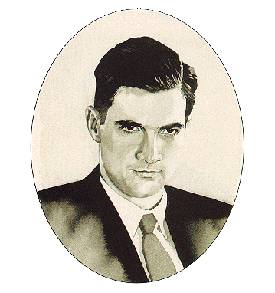WHO'S WHO - HOWARD R. HUGHES, JR.
 (1905-1976)
(1905-1976)
Although his eccentric behavior later in life cast a shadow over his career, Howard R. Hughes, Jr. left an indelible, if not distinctive, mark on business before his death in 1976.
Hughes was born into Houston society in 1905, the son of Hughes Tool Co. co-founder Howard Hughes Sr. He attended private schools out East and found his true passion, flying, as a teen on a plane trip to Boston with his father. When his parents both died before he reached adulthood, an already financially minded Hughes fought for his independence and convinced relatives to sell him the rest of the oilfield drill-making company he did not inherit.
Hughes had the means and quickly followed his desire to make movies in Hollywood, where he gained respect as a producer on such acclaimed films as "Hellís Angels" and "Scarface." But his greatest achievements came later in the aviation industry, where he launched Hughes Aircraft Co. as a division of Hughes Tool Co., took over and led Trans World Airways into the jet age, and participated in the design and testing of faster, longer-distance aircraft.
He is recognized in the Smithsonianís National Air and Space Museum in Washington, D.C., for setting an aircraft speed record of 352 mph in 1935 in his specially crafted Hughes H-1 racer. Hughes also worked with Lockheed to pioneer the Lockheed Constellation aircraft, one of the most important long-range airliners of the l940s and 50's.
Hughes, regarded as a businessman absorbed in his work and his empire, expanded the aircraft business into military contracting, helping to drive an almost obsessive interest in politics. He is believed to have donated heavily to political campaigns and fancied himself a political insider with pull at the highest ranks of government
After Hughes moved to Nevada in the late 1960s, TWA ran into legal trouble and he sold his stock for $546 million. He set about building an empire in Las Vegas, making several acquisitions that included regional airline Air West and an assortment of hotels and casinos.
He sold stock in Hughes Tool Co. to the public in 1972 and established his holding company as Summa Corp. in Las Vegas, but became increasingly reclusive, handling business primarily through memos. When he died after years of deteriorating mental and physical health, he left an estimated $2 billion estate for distant relatives to fight over.
Howard Hughes Medical Institute in Delaware, which the billionaire founded in 1953, inherited Hughes Aircraft Co. and sold it to General Motors Corp. in 1985 for $5 billion. Summa remained as a land development operation, initially holding the hotels and casinos, and in recent years was renamed The Howard Hughes Corp. The search for the inside story of Hughes the tycoon spawned many controversial articles and books after his death, including a December 1976 Time cover story "The Secret Life of Howard Hughes," revealing his reclusive years, and the 1984 expose "Citizen Hughes" in Playboy, detailing how Hughes tried to buy the U.S. Government. His incredible life is recounted in the 1979 Donald L. Bartlett tome, Empire: The Life, Legend, and Madness of Howard Hughes.






